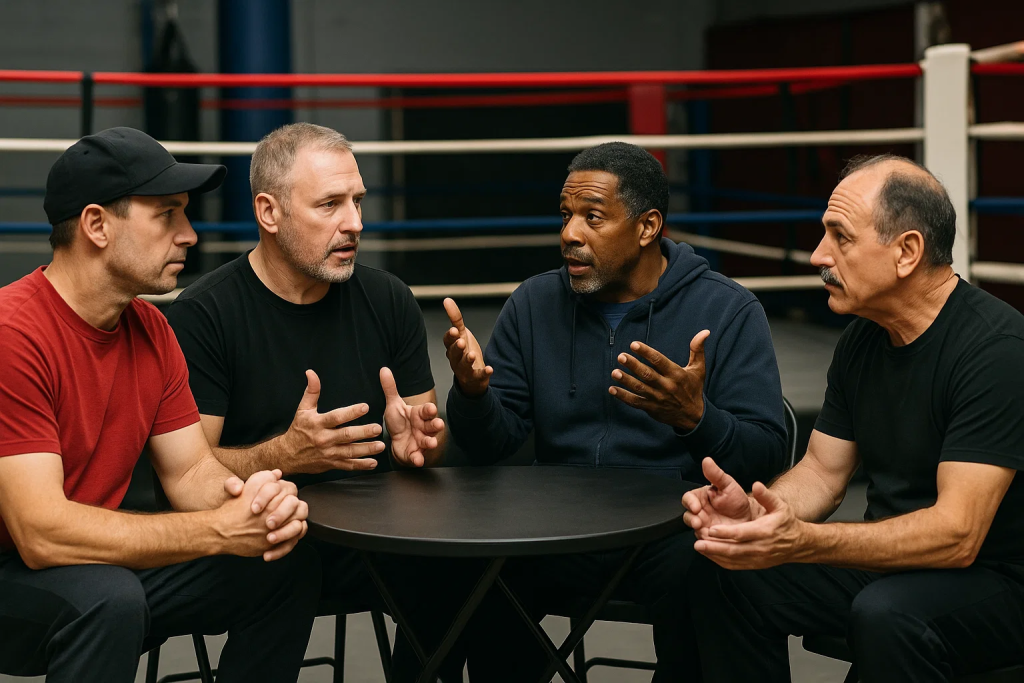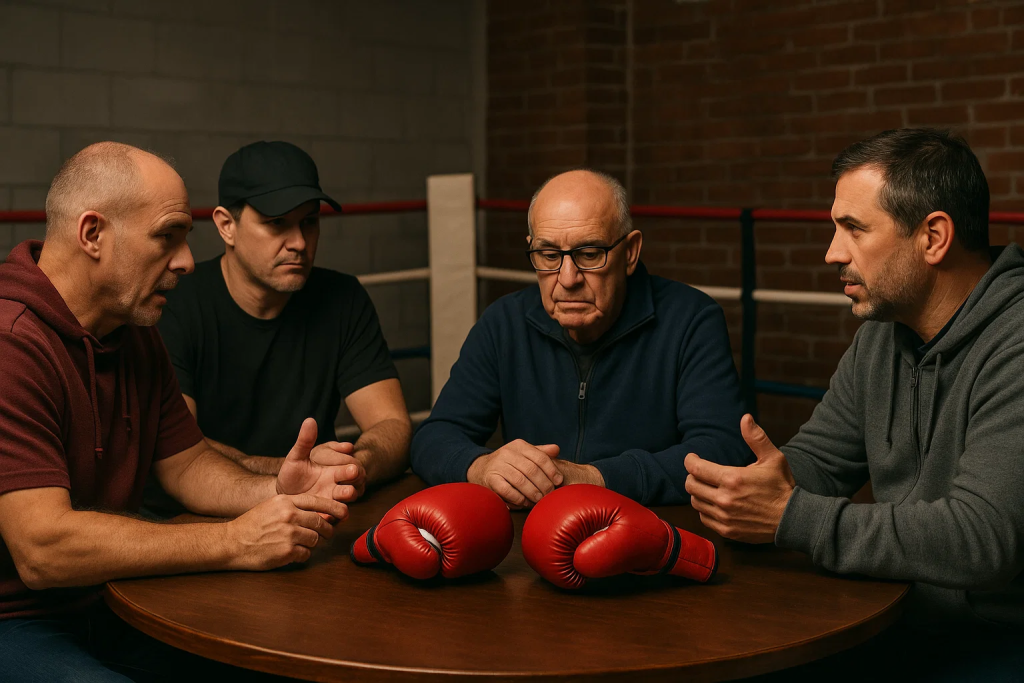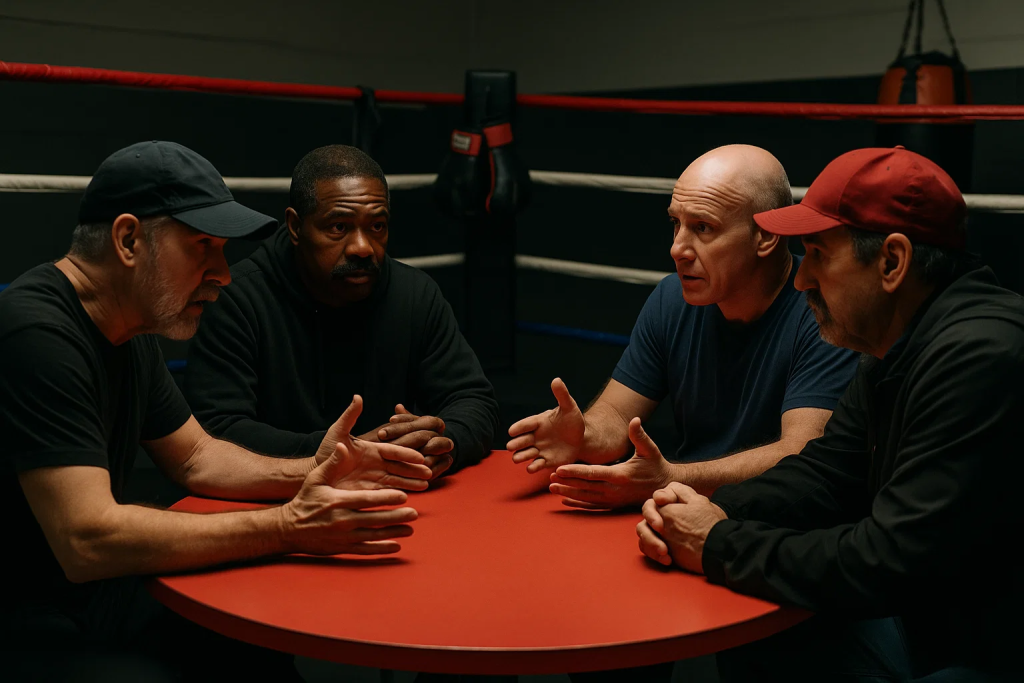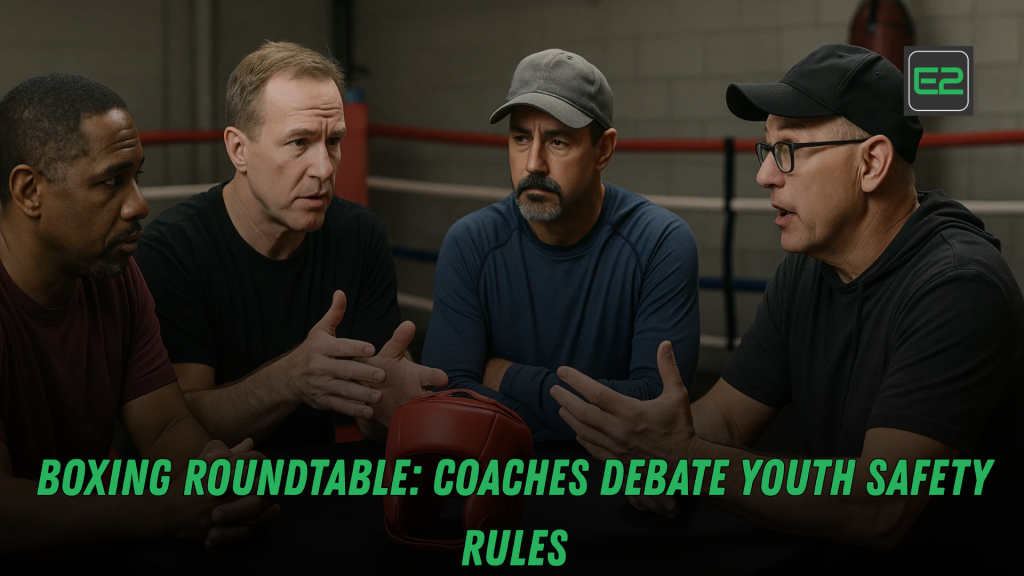Table of Contents
TL;DR (Executive Summary)
Youth boxing has always balanced two goals: protecting young athletes and teaching real fight skills. This roundtable-style guide distills what top coaches argue about—and where they actually agree—across hot-button topics like headgear, glove weight, bout length, sparring intensity, concussion protocols, dehydration/weight making, officiating standards, and parent education. You’ll get actionable checklists, a return-to-play ladder, a 30/60/90-day safety plan for gyms, and policy ideas for leagues and federations. The big picture: you can build durable, technical boxers without normalizing preventable injuries. That requires clear rules, honest communication, and data-driven decisions—not guesswork.

Why This Debate Matters Now
Three trends force a fresh look at youth boxing safety:
- Better science on brain health and sub-concussive exposure.
- Rising participation, especially in community programs where coaching resources vary.
- Public scrutiny: parents demand clear safeguards, transparent rules, and fast, fair decisions ringside.
Coaches aren’t anti-safety; they’re anti-unintended consequences. They worry that the wrong rule at the wrong age can distort skill development (for example, headgear that reduces peripheral vision) or give false confidence that leads to higher risk. This article separates myths from mechanics and focuses on what actually reduces harm without hollowing out the sport.
The Roundtable: Three Coaching Perspectives (and Common Ground)
Coach A — “Protect First, Always”
- Wants maximum protective measures for minors, especially under 15.
- Pushes for shorter bouts, lighter contact in sparring, strict stoppage thresholds, and mandatory headgear across youth.
- Prioritizes longer development runway; medals can wait.
Coach B — “Prepare for Reality”
- Emphasizes authentic ring situations with graduated exposure so athletes aren’t shocked at older divisions.
- Supports technical sparring early but argues over-protective rules can lead to sloppy habits and false sense of security.
Coach C — “Data & Balance”
- Advocates a tiered system: rules tighten or relax by age and experience, guided by injury data and athlete monitoring.
- Prefers objective thresholds (e.g., weekly sparring minutes, recovery windows, RPE logs) over blanket bans.
Where they agree:
- No tolerance for dehydration tactics, unsafe sparring, poor officiating, or weak concussion protocols.
- Parent education and coach certification are non-negotiable.
- Transparency beats rumor: rules should be posted, explained, and enforced consistently.
Safety by Design: The 10 Rules Young Boxers Feel, Not Just Read
1) Age-Appropriate Headgear
- Under 13: Headgear for all contact; emphasize vision drills to offset occlusion (peripheral awareness cues, posture).
- 13–16: Headgear for bouts; allow controlled technical sparring without head shots at coach discretion (see Sparring Ladder below).
- Above 16 (youth/junior): Follow governing-body rules; if no headgear in competition, phase exposure in-house with strict volume caps.
Roundtable note: Headgear reduces lacerations and superficial trauma, but doesn’t eliminate brain acceleration. It should complement, not replace, volume control and skill-first sparring.
2) Glove Weight and Hand Protection
- Youth divisions benefit from heavier gloves for sparring (14–16 oz depending on size) and proper wraps under coach supervision.
- Competition gloves follow sanctioning rules; coaches should teach palm parries, catch-and-pitch, and deflections that dissipate force, not just block with the skull.
3) Bout Length & Round Caps
- Under 13: 3×1:00 or 3×1:30 with longer rest; cap on daily bouts and total annual matches.
- 13–16: 3×2:00 with careful pacing; no back-to-back events on the same weekend for novices.
- Experience-based exemptions only with medical clearance + coach committee sign-off.
4) The Sparring Ladder (Intensity & Intent)
- Tier 0 (No head contact): body-only touch spar, footwork games, reaction drills.
- Tier 1 (Light, flow): headgear, 30–50% effort; coach calls “freeze” to correct guard and angles.
- Tier 2 (Technical live): scenario rounds (corner traps, fence exits, southpaw entries), still at 60–70% with strict time & volume.
- Tier 3 (Controlled live): occasional full-speed rounds for advanced youth with round limits and post-round neuro checks (symptom questions, balance).
Rule of thumb: More scenarios and constraints; fewer ego wars. The ladder builds decision-making without cashing out a young athlete’s health.
5) Concussion & Return-to-Play (RTP)
- Immediate removal on any sign of concussion. No same-day return.
- RTP Ladder (minimum 7–21 days, medical-guided):
- Symptom-free at rest → 2) light aerobic → 3) sport-specific (no contact) → 4) non-contact drills with HR elevation → 5) controlled contact → 6) full participation.
- Keep simple sideline checks ready (orientation, symptoms, smooth pursuit eye movements). Parents should understand the process beforehand.
6) Hydration, Weight Classes & Weigh-ins
- Ban sauna suits, plastic wraps, diuretics. Educate on gradual weight management: small deficits, long runway, no rapid cuts.
- Move to morning of competition or same-day weigh-ins to discourage drastic water loss (league-specific).
- Monitor growth spurts; reclassify weight when height/lean mass changes.
7) Medical Presence & Ring Stoppages
- Qualified ringside medical at events; gym keeps a written Emergency Action Plan (EAP) posted.
- When in doubt, wave it out. Stop early for youth; you can’t coach out a concussion.
8) Officiating & Corner Standards
- Certified referees for youth bouts; low threshold for standing 8 counts and stoppages.
- Corner must pass a youth-specific course: towel policies, between-round checks, safe-sport boundaries, communication.
9) Weekly Load Management
- Cap total sparring minutes per week; log RPE (1–10) and wellness (sleep, soreness, mood).
- For under 15: ≤2 technical spar days + 1 scenario/live day (short), never on consecutive days.
10) Culture & Language
- Replace “be tough” with “be tidy” and “be smart”. Reward defense, distance, and decision-making, not chin tests.

What the Research (Mostly) Agrees On
- Sub-concussive accumulation matters; many “little hits” can be meaningful across a season.
- Technique lowers exposure: balance, head movement, footwork, distance management, parry/roll skills reduce clean head impacts.
- Sleep, nutrition, and hydration are performance multipliers and injury reducers.
- Same-day return after suspected concussion is a hard no.
- Supervision quality—coach expertise, clear rules, medical presence—predicts safety more than any single piece of gear.
Key point: Safety isn’t one lever; it’s a system—training design, rules, equipment, coaching, officiating, and culture.
A Practical Toolkit for Coaches and Gyms
A) The Youth Boxing Safety Checklist (Post on the Wall)
Before season
- Parent orientation: rules, RTP, weigh-in policy, travel code.
- EAP: contacts, roles, nearest hospital, AED location.
- Coach certifications current; background checks; Safe-Sport training.
- Gear audit: gloves by size, headgear fit, clean wraps, mouthguards, ring mats.
Weekly
- Wellness log (sleep/stress/soreness).
- RPE & minutes tracked for sparring/conditioning.
- Recovery day scheduled after any live rounds.
- Skill blocks > slugfests (2:1 skill time : live time minimum).
Event day
- Medical on site; scales calibrated; hydration checks.
- Ref/officials brief: youth thresholds for stoppage.
- Bout sheet has emergency contacts and prior injuries.
- Post-bout symptom check, recovery instructions to parents.
B) 12 Red Flags That Trigger an Immediate Stop
- Loss of orientation or odd affect.
- Wobbly gait, balance loss.
- Headache, nausea, light sensitivity.
- Eyes not tracking smoothly.
- Slurred speech or delayed answers.
- Repeated clean head shots in a short window.
- “I’m fine” but obvious motor changes.
- Corner unable to stabilize athlete emotionally.
- Visible dehydration signs (cramps, dry mouth, dizziness).
- Coach/athlete “must win” mentality overriding safety.
- Parent pressure conflicting with medical advice.
- Any suspicion from any official: when in doubt, stop.
C) Return-to-Play in Plain Language (Parent Handout)
- Zero symptoms first. Then: walking, shadowboxing, mitt work (no head contact), controlled drills, light tech spar, clearance for competition. If symptoms return, drop back a step and rest 24–48 hours.
D) The Young Boxer’s Week (Example Under 15)
- Mon: Footwork school + defense layers (slip/roll/pivot).
- Tue: Technical mitts + body-only touch spar (Tier 0–1).
- Wed: Mobility + strength basics (hips, neck, posterior chain).
- Thu: Scenario rounds (Tier 2) with strict time caps.
- Fri: Video review + reaction games (pool noodle, lights).
- Sat: Community run + stretching, no head contact.
- Sun: Off, sleep early.
Weigh-Ins and Weight Talk Without the Myths
- Goal: compete near natural weight. Kids are growing, not cutting.
- Educate on lean proteins, complex carbs, fruits/veggies, dairy (if tolerated), and consistent hydration.
- Use seasonal growth checks: if a boxer “floats” 3–4 kg above class, move up rather than cutting.
- Shift pride from scale to consistency markers: sleep 8–9 hours, two liters of water/day (age-appropriate), balanced meals.
Officiating and Event Operations: Small Decisions, Big Safety
- Pre-bout briefings: re-state youth-specific thresholds, illegal targets, and your bias for early stoppage.
- Corner conduct: one voice, concise instructions, no yelling through fatigue.
- Crowd control: kids don’t need pressure cookers. Keep parents informed so they trust decisions.
- Matchmaking: experience parity matters more than records. Avoid mismatch psychology.
Data, Not Drama: How to Track Safety Without a Lab
- RPE (1–10) after sparring; note rounds/minutes.
- Sleep hours; DOMS (muscle soreness) score.
- Session purpose in the log (defense, distance, counters). If purpose ≠ outcome, adjust next session.
- Keep a simple incident log: nosebleeds, cramps, dizziness, stoppages, concussions. Trends guide rule tweaks.
Parent & Athlete Education: The Most Powerful PPE
- Hold quarterly town halls (30 minutes): RTP reminders, growth spurts & weight classes, travel rules, social media boundaries.
- Send one-page summaries after policy updates.
- Invite a sports medicine clinician once a season to answer questions.
- Train parents to ask, “How was your defense today?” instead of “Did you win?”
The Hard Topics Coaches Must Master
Dehydration Tactics
Prohibit and enforce. Post clear consequences (suspension, medical eval, re-education) for any boxer or corner caught promoting shortcuts.
Sparring Culture
Glorifying gym wars erodes skill and health. Feature technical champions in social posts—clean defense clips, ring IQ moments.
Social Media Pressure
Youth read comments. Set team policy: no posting sparring knockdowns, no clowning opponents online. Build a respect culture that outlives scoreboard highs and lows.
Sample Policies You Can Copy
1) “One-Stop” Concussion Rule
Any suspected concussion = same-day stop, medical check, minimum RTP protocol, coach/parent briefing. Violations by a corner → automatic suspension pending review.
2) “Water First” Weigh-in Protocol
All weigh-ins include a quick hydration screen (urine color chart guidance). Dehydration suspected → no bout, automatic re-schedule with education session.
3) “Ladder-Only” Sparring
No free-for-all. All sparring must be scheduled with tier level declared in the log and coach supervising; live rounds require post-round symptom checks.
4) “Young Athlete Media Code”
No head-trauma highlight posts. Emphasize defense, teamwork, sportsmanship. Require parental consent for any public content featuring minors.

30/60/90-Day Plan for Clubs
Next 30 Days
- Publish Safety One-Pager (RTP, hydration policy, sparring ladder).
- Run a parent orientation night.
- Create the EAP and post it at check-in.
- Start RPE + minutes logging for sparring.
By Day 60
- Coach in-service: concussion recognition, stoppage thresholds, scenario-based sparring design.
- Gear audit & replacements; fit-check headgear.
- Pilot defense-only Saturday: showcase skills in front of parents.
By Day 90
- First safety report: incidents, stoppages, RTP cases, sleep/hydration trends.
- Adjust sparring caps from data; refine bout matchmaking rules.
- Partner with a local sports med clinic for seasonal assessments.
Recommendations for Sanctioning Bodies & Leagues
- Standardize RTP and make it visible on bout sheets.
- Move toward same-day weigh-ins for youth to deter cuts (or publish a robust hydration policy if weigh-ins differ).
- Require youth-specific corner certification.
- Publish annual safety dashboards: stoppage rates, concussion counts (de-identified), average age-by-experience matching.
- Conduct random audits of gym sparring policies and require incident logs.
Case Scenarios (What Coaches Would Do)
Scenario 1: 12-year-old, first bout, overwhelmed by crowd.
- Coach A: headgear, 3×1:00, early stoppage threshold; pre-bout breathing routine.
- Coach B: keeps technical intent, calls defense-first combos, limits exchanges.
- Coach C: logs RPE, ensures full hydration, schedules more scenario rounds before the next meet.
Scenario 2: 15-year-old novice wants to drop a class in 10 days.
- All three coaches refuse rapid cut. Parents receive nutrition handout; athlete competes at natural weight.
Scenario 3: Mild symptoms post-spar.
- Immediate stop; medical check; RTP ladder begins. Parent gets written steps and a return appointment.
SEO Tips (Use Naturally)
Primary keywords: youth boxing safety rules, youth boxing headgear, youth boxing concussion protocol, safe sparring, boxing weigh-in policy, return to play boxing.
Secondary: youth boxing gloves, hydration policy boxing, officiating youth boxing, parent guide to youth boxing, boxing injury prevention.
Blend these in headers, meta, alt text, and body—never stuff.
University Leagues: Amazing Letran Knights’ Championship Strategy
Strong Call-to-Action
If you’re a coach, gym owner, or parent leader, commit to this three-part challenge today:
- Post your Safety One-Pager (RTP, hydration, sparring ladder) on the gym wall and website.
- Log sparring minutes + RPE for every youth session this week.
- Host a 30-minute parent huddle to explain stoppage thresholds and weight health.
Want an editable Youth Boxing Safety Kit (one-pager template, RTP ladder, hydration policy, sparring log, parent slide deck)? Message: “SEND SAFETY KIT” with your role (coach/parent/official) and club name. Let’s build a generation of smart, skillful, and safe young boxers.
Frequently Asked Questions (FAQ)
1) Does headgear prevent concussions?
Headgear reduces cuts and facial trauma and can soften direct impact, but it does not eliminate brain acceleration from sudden stops or rotational forces. It should be paired with volume control, skill-first sparring, and strict stoppage policies.
2) How much should kids spar each week?
There’s no magic number, but a safe pattern is 2 technical sessions (Tier 0–1) and 1 short scenario/live session (Tier 2–3) with rest after live rounds, logged by minutes and RPE. For under-15, keep live contact sparse and purposeful.
3) Are same-day weigh-ins better for youth?
They often discourage rapid dehydration. Whatever weigh-in timing is used, the gym must ban dehydration tactics, teach gradual weight management, and move kids up when natural weight rises with growth.
4) What’s the correct concussion protocol for boxing?
Remove immediately, no same-day return, and follow a stepwise RTP (rest → light aerobic → sport-specific no contact → controlled drills → controlled contact → full). The timeline is medical-guided and symptom-driven.
5) How do we convince parents the sport is safe?
Publish your rules and logs, invite parents to watch technical sessions, hold quarterly talks with a clinician, and communicate early stoppage bias. Show that your gym rewards defense, ring IQ, and respect, not head-hunting.
Final Word
Youth boxing can be a masterclass in courage and control—if adults make wise, transparent choices. The roundtable consensus is clear: protect brains, grow skills, respect growth, and keep parents in the loop. With headgear used intelligently, bout and sparring limits, real concussion care, and hydration-first weight policies, gyms can produce athletes who thrive in the ring and stay healthy for life.
